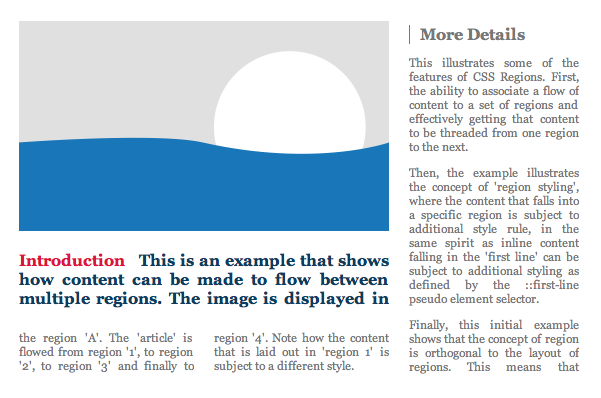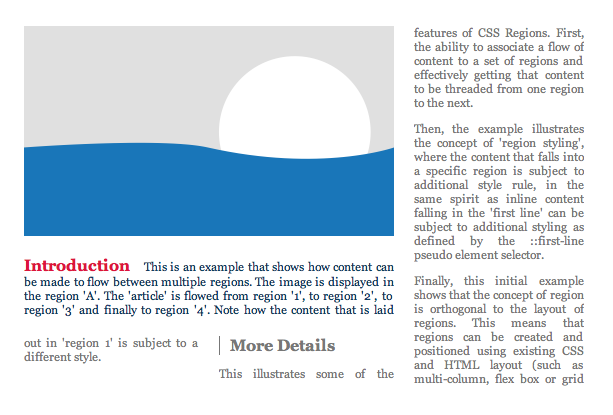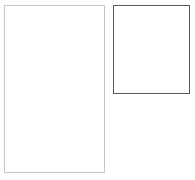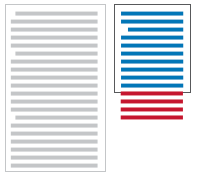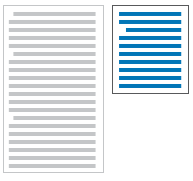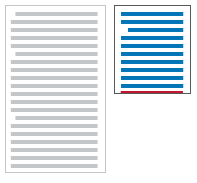
CSS Regions Module
W3C Working Draft 09 June
2011
- This version:
-
http://www.w3.org/TR/2011/WD-css3-regions-20110609/
- Latest version:
- http://www.w3.org/TR/css3-regions
- Previous version:
- none
- Editors:
- Vincent Hardy, Adobe Systems, Inc., vhardy@adobe.com
- Authors and Former Editors:
- Stephen Zilles, Adobe Systems, Inc., szilles@adobe.com
- Alexandru Chiculita, Adobe Systems, Inc., achicu@adobe.com
- Andrei Bucur, Adobe
Systems, Inc., abucur@adobe.com
- Mihnea Ovidenie, Adobe Systems, Inc., mihnea@adobe.com
- Peter Sorotokin, Adobe Systems, Inc., psorotok@adobe.com
- Virgil Palanciuc, Adobe Systems, Inc., virgilp@adobe.com
- Arno Gourdol, Adobe
Systems, Inc., agourdol@adobe.com
Copyright © 2011 W3C® (MIT, ERCIM, Keio), All Rights Reserved. W3C liability,
trademark
and document
use rules apply.
Abstract
The CSS Regions module allows content to flow across multiple areas
called regions. The regions do not necessarily follow the document order.
The CSS Regions module provides an advanced content flow mechanism, which
can be combined with positioning schemes as defined by other CSS modules
such as the Multi-Column Module [CSS3COL] or the Grid Layout Module
[CSS3-GRID-LAYOUT] to
position the regions where content flows.
Status of this
document
This section describes the status of this document at the time of
its publication. Other documents may supersede this document. A list of
current W3C publications and the latest revision of this technical report
can be found in the W3C technical reports
index at http://www.w3.org/TR/.
Publication as a Working Draft does not imply endorsement by the W3C
Membership. This is a draft document and may be updated, replaced or
obsoleted by other documents at any time. It is inappropriate to cite this
document as other than work in progress.
The (archived) public
mailing list www-style@w3.org (see
instructions) is preferred
for discussion of this specification. When sending e-mail, please put the
text “css3-regions” in the subject, preferably like this:
“[css3-regions] …summary of
comment…”
This document was produced by the CSS Working Group (part of
the Style Activity).
This document was produced by a group operating under the 5 February
2004 W3C Patent Policy. W3C maintains a public list of any patent disclosures made in
connection with the deliverables of the group; that page also includes
instructions for disclosing a patent. An individual who has actual
knowledge of a patent which the individual believes contains Essential
Claim(s) must disclose the information in accordance with section
6 of the W3C Patent Policy.
This is a First Public Working Draft.
Table of contents
1. Introduction
Capturing the complex layouts of a typical magazine, newspaper, or
textbook requires capabilities beyond those available in existing CSS
modules. This is the purpose of the CSS Regions module.
The CSS Regions module can be seen as an extension of the concept of
multi-column elements. With CSS Multi-column layout [CSS3COL], columns share the same
dimensions and define column boxes organized in rows. Content flows from
one column to the next.
The multi-column model is an example of flowing content from one area to
another, where the areas are the multi-column element's column boxes and
the flow is made of the multi-column element's children.
However, for more complex layouts, content needs to flow from one area
of the page to the next without limitation of the areas' sizes and
positions. These arbitrary areas are the target of specific content flows.
In this document these areas are called regions, and the content flows are
called named flows. Regions are based on the rectangular geometry of the
CSS box model. Elements in a named flow are taken out of the normal visual
formatting and rendered in a chain of regions.
1.1. Named flows
and regions
Consider the layout illustrated in figure 1.
The designer's intent is to position an image in region ‘A’ and to flow an article's text from region
‘1’, to region ‘2’, ‘3’ and
‘4’.
The following code snippet shows the content to flow between the regions
1, 2, 3 and 4.
<div id="article">
<h1>Introduction</h1>
<p>This is an example ...</p>
<h1>More Details</h1>
<p>This illustrates ...</p>
<p>Then, the example ...</p>
<p>Finally, this ...</p>
</div>
CSS layout facilities can position and size regions as needed. However,
there is no existing mechanism to associate the content with the regions
so that content flows as intended. Figure 2 shows an example of the
intended visual rendering of the content.
Since the CSS Regions module is independent of the layout of regions and
the mechanism used to create them, the following assumes there is a CSS
selector for the regions and, for the purpose of the example, the
selectors for regions 1, 2, 3 and 4 show as ‘<region1_sel>’, ‘<region2_sel>’, ‘<region3_sel>’ and ‘<region4_sel>’ respectively. Such a selector
could be an id selector (e.g., ‘#region_1’) or a grid cell selector (e.g.,
‘#myGrid::grid-cell([cell-name])’) if
using the CSS Grid Layout module, for example.
<style>
#article {
flow: article_flow;
}
<region1_sel>, <region2_sel>,
<region3_sel>, <region4_sel> {
content: from-flow(article_flow);
}
</style>
The above stylesheet directs the ‘#article’ element to a named flow called
‘article_flow’ by setting the ‘flow’ property. Then,
content is "poured" from that named flow into the desired regions by
setting the regions' ‘content’ property to ‘from-flow(article_flow)’.
1.2. Regions Styling
Region styling allows content to be styled depending on the region it
flows into. It is a form of context-based styling, similar to Media
Queries [MEDIAQ]
which enable or disable selectors depending on the rendering context. With
region styling, additional selectors may apply depending on the region
into which content flows.
In our example, the designer wants to make text flowing into region 1
larger, bold and dark blue. In addition, <h1> headers should be run-ins and crimson.
This design can be expressed with region styling as shown below.
<style>
/*
* Default article styling.
*/
#article {
color:#777;
text-align: justify;
}
#article h1 {
border-left: 1px solid #777;
padding-left: 2ex;
}
/*
* Additional styling to apply to content when it falls into
* region_1
*/
@region <region1_sel> {
#article::region-lines {
font-weight: bold;
color: #0C3D5F;
font-size: larger;
}
#article h1 {
color: crimson;
display: run-in;
border: none;
padding: 0px;
}
}
</style>
The ‘@region’ rule for region 1
limits its selectors to content flowing into region 1. The following
figure shows how the rendering changes if we do not increase the font size
nor make it bold for content flowing into region 1. As more content can be
fitted, more content is subject to the contextual selectors, resulting in
more dark blue text into region 1.
The ‘::region-lines’ pseudo-element
is described later in this specification.
2. CSS Regions Model
2.1. Named flows
In the CSS formatting
model, elements can be in the normal
flow or out of the (normal)
flow. Boxes generated by elements in the normal flow are subject
to their container box's normal layout scheme. Boxes generated by elements
out of the normal flow are subject to a different layout scheme. For
example, absolutely positioned elements are subject to absolute
positioning into their containing
block. This can be described by saying that the absolutely positioned
elements are part of a special flow (called positioned flow) which is subject to a special
layout by its container box (i.e., its container box positions it into the
containing block's box).
In both cases, there is a notion of flow containing a sequence of
elements and there is a notion of (block)
container box into which the elements flow.
The CSS Regions module generalizes the concept of flow by adding the
concept of a named flow. This module lets authors explicitly
place elements into a named flow.
With this model, all elements are moved to a flow as part of the visual
formatting. That flow may be the normal flow, a named flow or a positioned
flow, for example. A flow gets formatted visually when associated with one
or several elements' container box(es). When an flow is associated with
container boxes, the boxes generated by the flow's elements are laid out
according to the container box's layout scheme and the flow is subject to
the ‘flow breaking
rules’ described below.
A container's layout scheme is the strategy used by a container to
position the boxes generated by its children and itself. Examples are the
normal layout (block and inline formatting) ([CSS21]), table layout ([CSS21]), the
multi-column layout ([CSS3COL]) or the grid layout ([CSS3-GRID-LAYOUT]).
2.2. Regions
A region is an element that generates
a block
container box and has an associated named flow (see the
‘content’ property).
A region‘s intrinsic
width is zero.
2.3. Flow breaking
rules
Breaking a named flow across multiple regions is similar to breaking a
document’s content across multiple pages. One important difference
is that page boxes are generated based on the available content whereas
regions are a predefined set of recipients for the named flow content.
2.3.1. Breaking a named flow and determining the
current flow region
The ‘content-order’ property defines how regions are organized in to a region chain.
Each region in turn consumes content from its associated named flow. This means that the named flow content
is positioned in the current
region until a region break occurs, at which point the current region becomes the
next one in the region chain. If there is
no more region in the region chain and there is still content
in the flow, the positioning of the remaining content is controlled by the
‘region-overflow’ property on the last
region in the chain.
The following sections define where region breaks may happen when
positioning a named flow across regions in a
region chain.
The sections on "Allowed region breaks", "Forced region breaks" and
""Best" region breaks" are adapted from the [CSS21] specification. There is an
updated version of these paragraphs in [CSS3PAGE] as well.
In addition, the CSS Multi-column Layout Module [CSS3COL] defines unified breaking
properties (which this specification extends).
It seems that we should:
- Define a common set of rules for breaking content that accounts for
pages, columns and regions.
- Define the properties for breaking content in a single specification
as well.
- Specify how column, page and region breaks interact.
2.3.2. Allowed region
breaks
In a named flow, region breaks can occur at the following places:
- In the vertical margin between block-level boxes. When an unforced
region break occurs here, the used values of the relevant
‘
margin-top’ and ‘margin-bottom’ properties are set
to ‘0’. When a forced region break
occurs here, the used value of the relevant ‘margin-bottom’ property is set to
‘0’; the relevant ‘margin-top’ used value may either
be set to ‘0’ or retained.
- Between line boxes inside
a block container box.
- Between the content edge of a block container box and the outer edges
of its child content (margin edges of block-level children or line box
edges for inline-level children) if there is a (non-zero) gap between
them.
These breaks are subject to the following rules:
- Rule A: Breaking at (1) is allowed only if the
‘
break-after’ ‘break-before’
properties of all the elements generating boxes that meet at this margin
allow it, which is when at least one of them has the value ‘always’, ‘left’, or ‘right’, or when all of them are ‘auto’.
- Rule B: However, if all of them are ‘
auto’ and a common ancestor of all the
elements has a ‘break-inside’ value of ‘avoid-region’, then breaking here is not
allowed.
- Rule C: Breaking at (2) is allowed only if the number
of line boxes between the
break and the start of the enclosing block box is the value of
‘
orphans’ or more, and the number
of line boxes between the break and the end of the box is the value of
‘widows’ or more.
- Rule D: In addition, breaking at (2) or (3) is
allowed only if the ‘
break-inside’ property of the element and
all its ancestors is ‘auto’.
If the above does not provide enough break points to keep content from
overflowing the region boxes, then rules A, B and D are dropped in order
to find additional breakpoints.
If that still does not lead to sufficient break points, rule C is
dropped as well, to find still more break points.
2.3.3. Forced region
breaks
A region break must occur at (1) if, among the ‘break-after’ and
‘break-before’ properties of all the
elements generating boxes that meet at this margin, there is at least one
with the value ‘always’,
‘left’, or ‘right’.
2.3.4. "Best" region
breaks
CSS 2.1 does not define which of a set of allowed region
breaks must be used; CSS 2.1 does not forbid a user agent from
breaking at every possible break point, or not to break at all. But
CSS 2.1 does recommend that user agents observe the following
heuristics (while recognizing that they are sometimes contradictory):
- Break as few times as possible.
- Avoid breaking inside a replaced element.
Example(s):
Suppose, for example, that the style sheet contains ‘orphans: 4’, ‘widows:
2’, and there are 20 lines (line boxes) available at the
bottom of the current region:
- If a paragraph at the end of the current region contains 20 lines or
fewer, it should be placed on the current region.
- If the paragraph contains 21 or 22 lines, the second part of the
paragraph must not violate the ‘
widows’ constraint, and so the
second part must contain exactly two lines
- If the paragraph contains 23 lines or more, the first part should
contain 20 lines and the second part the remaining lines.
Now suppose that ‘orphans’ is ‘10’, ‘widows’ is ‘20’, and there are 8 lines available at the bottom
of the current region:
- If a paragraph at the end of the current region contains 8 lines or
fewer, it should be placed on the current region.
- If the paragraph contains 9 lines or more, it cannot be split (that
would violate the orphan constraint), so it should move as a block to
the next region.
This section describes the flows to which elements formatted according
to the CSS Visual
Formatting Model and other layout modules (such as Multi-Column Layout
[CSS3COL])
belong to.
In particular, this section describes the ‘generated
flow’ where generated content of pseudo-elements is
placed and several ‘auto flows’ where children of content
elements are automatically placed.
2.4.1. Normal flow
In the CSS formatting model, elements are by default placed in the normal flow of their container. Also by default,
a container element gets its content from its normal flow. This means that by
default, a container element will visually format its children elements
and will be the only container associated with its normal flow.
Note that floats and relatively positioned elements, in this model, are
part of the same flow of content and flow into the same container but are
positioned in different ways.
The normal flow is one of the auto flows.
2.4.2. Positioned flow
An absolutely positioned element is placed into the positioned flow of its
container. The container positions this element into its containing
block.
If a container has children in the normal
flow and in the positioned flow, it applies different
positioning schemes to each flow.
The positioned flow is one of the auto flows.
2.4.3. Column flow
Children of the multi-column element are placed in the element's column flow. The column boxes are then implicitly
associated with the element's ‘column flow’. In this model, multiple regions
(column boxes) get their content from a single flow (the element's
‘column
flow’, which is the content of the element).
The column flow is one of the auto flows.
Need to add a grid cell flow
section.
Need to add examples for the different flow types.
2.4.4. Generated flow
In the CSS formatting model, when the ‘::before’ or ‘::after’ pseudo-elements have their content
property set to one of ‘<string>’, ‘<uri>’, ‘<counter>’, ‘attr(<identifier>)’, ‘open-quote’, ‘close-quote’, ‘no-open-quote’ or ‘no-close-quote’, they create a generated flow which they format visually.
2.5. Relation
to document events
The CSS Region module does not alter in any way the normal processing of
events in the document tree. In particular, if an event occurs on an
element that is part of a named flow, the event's
bubble and capture phases happen following the document tree order.
Should we consider having something to be able to add event listeners
to a region to detect events happening in the range of the flow it
positions?
<script>
var region = ...; // get DOM reference to region
region.addEventListener('click', function (evt) {
alert('I was able to capture an event from the flow content!');
}, true /* useCapture */);
region.addEventListener('click', function (evt) {
alert('I was able to see an event bubble from the flow content!');
}, false /* useCapture */);
Note that this is a complex proposition since it modifies the normal
bubble and capture event propagation model. However, it seems that it
would be a worthwhile feature.
3. Properties and
Rules
The main CSS Regions module properties are the ‘flow’ and ‘content’
properties. The ‘flow’ property places an element into a specific
named flow or lets the automatic flow assignment
take place. The ‘content’ property binds a region with a flow. When
multiple regions are bound to the same flow, the ‘content-order’
property determines the order in which content flows into the sequence of
regions. This sequences of regions is called a region
chain.
The way in which the content is broken into segments that fit in a
region can be controlled by the “break” properties. Finally, styling
that is unique to the region can be specified by ‘region-style’ rules.
3.1. The ‘flow’ property
The ‘flow’ property places an element into a named flow or
automatically places it in the appropriate flow (see the Visual Formatting
Model and Flows section). Elements that belong to the same flow are laid
out in the regions associated with that flow.
| Name:
| flow
|
| Value:
| <string>
|
| Initial:
| auto
|
| Applies to:
| any element
|
| Inherited:
| no
|
| Percentages:
| N/A
|
| Media:
| visual
|
| Computed value:
| as specified
|
- auto
- The element is automatically moved to the appropriate flow according
to the Visual Formatting Model and Flows definitions.
- <string>
- The element is placed (appended) to the flow with that name. The
element is said to have a specified flow.
Should the ‘
flow’ property be an identifier and not a
string?
A named flow needs to be associated with one or more regions for its
elements to be visually formatted. If no region is associated with a given
named flow, the elements in the named flow are not rendered: they do not
generate boxes and are not displayed.
The children of an element with a specified flow may themselves have a
specified flow.
If an element has a the same specified flow value as one of its
ancestors, it is moved out of its parent's normal flow and becomes a
sibling of it's ancestor for the purpose of layout in the regions taking
content from this flow.
The ‘flow’
property does not affect the CSS cascade and inheritance for the elements
on which it is specified. The flow property affects the visual formatting
of elements associated to a named flow and of regions getting their
content from a named flow.
The containing block for absolutely positioned descendants of an element
with a specified flow is the region into which the element is rendered.
All the elements participating inside a named flow are rendered as
children of an anonymous block that spans across all the regions
associated with the specified named flow. The elements flowed inside the
same named flow are taken in document order.
Regions create a new stacking context, but
inherit the floats that are already defined by the parent context.
In the following example, the inline content coming from the content named flow wraps around the #float box.
<style>
#float {
float: left;
width: 100px;
height: 300px;
}
#region1, #region2 {
width: 200px;
height: 200px;
content: from-flow(body_text);
}
#content {
flow: body_text;
}
</style>
<div id="float"></div>
<div id="region1"></div>
<div id="region2"></div>
<div id="content"></div>
3.2. The ‘content’
property
This specification extends the definition of the ‘content’
property and makes it applicable to all block elements and
pseudo-elements.
| Name:
| content
|
| Value:
| normal | none | from-flow(<string>)| [ <string> |
<uri> | <counter> | attr(<identifier>) | open-quote |
close-quote | no-open-quote | no-close-quote ]+ | inherit
|
| Initial:
| normal
|
| Applies to:
| non-replaced block elements and the ::before and ::after
pseudo-elements
|
| Inherited:
| no
|
| Percentages:
| N/A
|
| Media:
| visual
|
| Computed value:
| as specified
|
- none
- For ‘
::before’ and ‘::after’ pseudo-elements, the pseudo-element is
not generated. For other elements, the element will not get any content
for its visual formatting. If the children of the element are not
directed to a flow referenced by another region, then they are not
visually formatted. An element with its value set to ‘none’ is said to be disconnected
- normal
- Computes to ‘
none’ for the
‘::before’ and ‘::after’ pseudo-elements. For other elements, the
element uses the flow assigned to its children following the automatic flow assignment for the Visual Formatting
Model..
- <string>
- Text content (see the section on strings).
- <uri>
- The value is a URI that designates an external resource (such as an
image). If the user agent cannot display the resource it must either
leave it out as if it were not specified or display some indication that
the resource cannot be displayed.
- <counter>
- Counters may be specified
with two different functions: ‘
counter()’ or ‘counters()’. The former has two forms:
‘counter(name)’ or
‘counter(name,
style)’. The generated text is the value of the
innermost counter of the given name in scope at this pseudo-element; it
is formatted in the indicated style (‘decimal’ by default). The latter function
also has two forms: ‘counters(name,
string)’ or ‘counters(name, string,
style)’. The generated text is the value of all
counters with the given name in scope at this pseudo-element, from
outermost to innermost separated by the specified string. The counters
are rendered in the indicated style (‘decimal’ by default). See the section on automatic counters and numbering for more
information. The name must not be ‘none’, ‘inherit’ or ‘initial’. Such a name causes the declaration
to be ignored.
- open-quote and close-quote
- These values are replaced by the appropriate string from the ‘
quotes’ property.
- no-open-quote and no-close-quote
- Introduces no content, but increments (decrements) the level of
nesting for quotes.
- attr(X)
- This function returns as a string the value of attribute X for the
subject of the selector. The string is not parsed by the CSS processor.
If the subject of the selector does not have an attribute X, an empty
string is returned. The case-sensitivity of attribute names depends on
the document language.
- from-flow(<string>)
- The element will visually format the available elements in the named
flow with name <string>. If there is no flow with name
<string>, then the element is disconnected and does not format any
children visually. Multiple elements may be associated with the same
named flow. See the ‘
content-order’ property discussion to
understand how content segments are associated with different regions.
The ‘content’ property applies to block-level
elements and the ‘::before’ and
‘::after’ pseudo elements. User agents
may apply the content property to inline elements. The behavior is
undefined in that case, but is generally expected to be similar to that
of inline ‘::before’ and ‘::after’ pseudo-elements.
In particular, note that the behavior of a ‘::before’ or ‘::after’ pseudo-element with a ‘display’ value that makes it an inline
element combined with a ‘content’ value set to ‘from-flow(<name>)’ is undefined.
Should we consider adding the ability to do the following:
- Support repeatable content. For example, have a repeatable heading at
the start of each region where content flows.
- Support flow breaking marks. It might be very useful to support a
mark (such as "
...") at the region
breaking points to indicate that content has been broken out and is
continuing on a different region.
Mailing
list comment
‘content: from-flow(<name>)’
moves an element to a named flow. Should we allow the content to be
copied to a flow instead of moved to a flow. For example:
#quote_A { flow: "quotes"; content: contents; }
would keep ‘#quote_A’ in the normal
flow but also copy its content to the ‘quotes’ flow. This essentially clones the node and
raises questions regarding DOM access, CSSOM View and the computed style.
Defines the ordering of the chain of regions into which content flows.
If region A and region B are in the same chain of regions and the
‘content-order’ of region A is lower than that of region B, then
region A will precede region B in that chain: content will flow into
region A before it flows into region B.
| Name:
| content-order
|
| Value:
| <float>
|
| Initial:
| 0
|
| Applies to:
| any block container
|
| Inherited:
| no
|
| Percentages:
| N/A
|
| Media:
| visual
|
| Computed value:
| as specified
|
- <float>
- Specifies the region's priority in the chain it belongs to, i.e.., the
chain of regions associated with the same content flow. Negative values
are allowed.
If two or more regions with the same ‘from-flow(
<name>)’ value for their ‘content’
property, they are first sorted according to their ‘content-order’
value. If multiple regions in have the same ‘content-order’
value, they are sorted according to the document order.
CSS Modules should define the document order for pseudo
elements. For example, the [CSSGRID] specification should define the
document order for the ‘::grid-cell’
pseudo elements (e.g., row-major sorting or column major sorting of
cells).
When content is laid out in multiple regions, the user agent must
determine where content breaks occur. The problem of breaking content into
segments fitting in regions is similar to breaking content into pages or
columns.
Each break ends layout in the current region and causes remaining pieces
of content from the named flow to be visually formatted in the following
region, in the order defined by the ‘content-order’ computed values. Note that
there is no region break in the last region associated with a named flow.
The following extends the ‘break-before’, ‘break-after’ and
‘break-inside’ properties from the [CSS3COL]
specification to account for regions. The additional values are described
below.
| Name:
| break-before
|
| Value:
| auto | always | avoid | left | right | page | column | region |
avoid-page | avoid-column | avoid-region
|
| Initial:
| auto
|
| Applies to:
| block-level elements
|
| Inherited:
| no
|
| Percentages:
| N/A
|
| Media:
| paged
|
| Computed value:
| specified value
|
| Name:
| break-after
|
| Value:
| auto | always | avoid | left | right | page | column | region |
avoid-page | avoid-column | avoid-region
|
| Initial:
| auto
|
| Applies to:
| block-level elements
|
| Inherited:
| no
|
| Percentages:
| N/A
|
| Media:
| paged
|
| Computed value:
| specified value
|
| Name:
| break-inside
|
| Value:
| auto | avoid | avoid-page | avoid-column | avoid-region
|
| Initial:
| auto
|
| Applies to:
| block-level elements
|
| Inherited:
| no
|
| Percentages:
| N/A
|
| Media:
| paged
|
| Computed value:
| specified value
|
These properties describe page, column and region break behavior
before/after/inside the generated box. These values are normatively
defined in [CSS3COL]:
- auto
- Neither force nor forbid a page/column break before (after, inside)
the generated box.
- always
- Always force a page break before (after) the generated box.
- avoid
- Avoid a page/column break before (after, inside) the generated box.
- left
- Force one or two page breaks before (after) the generated box so that
the next page is formatted as a left page.
- right
- Force one or two page breaks before (after) the generated box so that
the next page is formatted as a right page.
- page
- Always force a page break before (after) the generated box.
- column
- Always force a column break before (after) the generated box.
- avoid-page
- Avoid a page break before (after, inside) the generated box.
- avoid-column
- Avoid a column break before (after, inside) the generated box.
This specification adds the following new values:
- region
- Always force a region break before (after) the generated box.
- avoid-region
- Avoid a region break before (after, inside) the generated box.
When a break splits a box, the box's margins, borders, and padding have
no visual effect where the split occurs. However, the margin immediately
after a forced page/column/region break will be preserved. A forced
page/column/region break is a break that does not occur naturally.
Note: When the ‘avoid’ value is used, regions may overflow. In
that case the ‘overflow’ property specified on the region
element should be used to determine how to render the overflow.
3.5. The
region-overflow property
| Name:
| region-overflow
|
| Value:
| auto | break
|
| Initial:
| auto
|
| Applies to:
| region elements
|
| Inherited:
| no
|
| Percentages:
| N/A
|
| Media:
| paged
|
| Computed value:
| specified value
|
The ‘region-overflow’ property controls the
behavior of the last region associated with a
named flow.
- auto
- Content flows as it would in a regular content element. If the content
exceeds the container box, it is subject to the overflow
property's computed value on the region element.
- break
- If the content fits within the region element, then this
property has no effect. If the content does not fit within the region
element, the content breaks as if flow was going to continue in a
subsequent region. See the breaking rules section.
The following code sample illustrates the usage of the ‘region-overflow’ property.
<style>
#article {
flow: "article";
}
#region_1, #region_2 {
content: from-flow(article);
region-overflow: break; /* or none */
overflow: visible; /* or hidden */
}
</style>
<div id="article">...</div>
<div id="region_1"></div>
<div id="region_2"></div>
3.6. The @region
rule
An ‘@region’ rule contains style
declarations specific to particular regions.
The ‘@region’ rule consists of the
keyword ‘@region’ followed by a selector
and a declarations block. The ‘@region’
rule and the selector constitute the region's ‘flow
segment’ selector. The region's flow segment selector
specifies which range of elements in the flow are subject to the following
declaration blocks: it applies to the range (see [DOM-LEVEL-2-TRAVERSAL-RANGE])
from the region's flow that flow in the selected region(s).
Only elements that are fully in the ‘flow
segment’ may match any of the selectors found in the style
rule. If an element is split across regions, it will not be subject to
region styling in any of the regions it is part of. However, it's children
element or pseudo-elements may be.
In addition, the ‘::region-lines’
pseudo-element can be used to select the inline content of an element that
falls into a particular region.
@region <selector> {
... CSS styling rules ...
}
In the following example, the named flow ‘article_flow’ flows through ‘region_1’ and ‘region_2’.
<style>
#div_1 {
flow: "article_flow";
}
<region1_sel>, <region2_sel> {
content: from-flow(article_flow);
}
/* region style RSA */
@region <region1_sel>, <region2_sel> {
p::region-lines {...}
div {...}
p {...}
}
/* region style RSB */
@region <region1_sel> {
p {...}
#p_2::region-lines {...}
}
</style>
<div id="div_1">
<p id="p_1">...</p>
<p id="p_2">...</p>
</div>
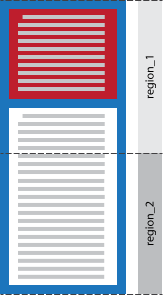
- div div_1
- paragraph
p_1
- paragraph
p_2
- range of
flow that fits into region_1
- range of
flow that fits into region_2
The region style ‘RSA’ applies to
flow content that fits in either ‘region_1’ or ‘region_2’.
The first rule set ‘p::region-lines
{...}’ uses the ‘::regions-line’ pseudo-element. Since all the
content is fitted in either ‘region_1’
or ‘region_1’, this rule set applies
to all content lines.
The second rule set ‘div {...}’
applies to all <div> elements that fit
fully into ‘region_1’ or ‘region_2’. In our example, there is no <div> in the flow that fits fully in a region,
because div_1 is split between ‘region_1’ and ‘region_2’.
The third rule set ‘p {...}’ applies
to all <p> elements that fit fully into
‘region_1’ or ‘region_2’. In our example, only p_1 fully fits in a region, ‘region_1’.
The region style ‘RSB’ applies to
flow content that fits in ‘region_1’.
The first rule set ‘p {...}’ matches
p_1 because that paragraph fully fits in
‘region_1’.
The second rule set ‘#p_2::region-lines
{...}’ matches lines in p_2 that
flow into ‘region_1’. These lines will
be subject to the additional style.
Is the proposed restriction that elements are only
selected selector in a rule set appearing in an @region rule sufficient?
There is
concern
that the ‘
first-line’ precedent is
underspecified and that more specification is needed in addition to
referencing the existing precedent.
The specificity of the selectors in a ‘@region’ rule is calculated as defined in the
CSS Selectors module (see [SELECT]). In other words, the
‘@region’ rule adds an extra condition
to the selector's matching, but does not change the selector's
specificity. This is the same behavior as selectors appearing in
‘@media’ rules declaration blocks (see
[MEDIAQ]), where
the rule does not influence the selectors' specificity.
Consequently, selectors that match a given element (as describe above),
participate in the CSS Cascading order as defined in [CSS21].
4. CSSOM View
and CSS Regions
Since content may flow into multiple regions, authors need a way to
determine if there are enough regions to flow all the content from a named
flow. This is especially important considering that the size of regions
may change depending on the display context. For example, flowing the same
content on a mobile phone with a small screen may require more regions
than on a large desktop display.
Here is another example where creating more regions might be needed. If
the user may change the font size of text flowing through regions, new
regions may be needed to accommodate for the additional space required to
fit the larger text or some may need to be removed for smaller text.
The CSS OM View ([CSSOM-VIEW]) specification
defines extensions to the Element interface that
would let an author find out if the last region overflows its content
boundaries (by comparing its ‘scrollHeight’ with its ‘contentHeight’). However, this assumes the
region is a document element, which may not always be the case. For
example, as described in a later section, a grid cell (see [CSS3-GRID-LAYOUT]) may be
a region, but it is a pseudo-element, not an document element. Therefore,
it is not possible to access its ‘scrollHeight’ or ‘contentHeight’.
Since an element may be split into multiple regions, invoking getClientRects
on it must return the list of rectangles for the element in all the
regions it is part of.
4.1. The NamedFlow
interface
This specification adds a method to the Document interface to access the document's named flow instances.
[Supplemental] interface Document {
NamedFlow flowWithName(DOMString name);
};
The NamedFlow
interface offers a representation of the named flow.
interface NamedFlow {
readonly attribute boolean overflow;
};
The overflow
property is true if the named flow does not fully fit in the associated
regions. Otherwise, it is false.
With the NamedFlow
interface, authors can easily check if all content has been fitted into
existing regions. If it has, the overflow property would be true.
See Mailing
list discussion.
Alex has suggested to not have a NamedFlow interface but instead expand
the Element interface to provide access to the regions (e.g., does the
flow fit? which flow elements fall into which region?) and pointed out
that the NamedFlow
interface implies there is only one view on the flow. He asked that we
prepare for multiple views.
Alex's proposal has been added (see below) but the NamedFlow interface was
kept for now because it covers the most basic need (does the flow fit?)
in the case where regions are not elements.
There needs to be a discussion about how to get a single set of APIs
that would both be ‘multi-view’
ready and work on elements and pseudo-elements.
4.2.
Extension to the Element interface
When an region is an actual element,
it is convenient to easily find out if content fully fits into the
region or not. The supplemental interface on Element provides that functionality.
[Supplemental] interface Element {
readonly attribute DOMString regionOverflow;
readonly Range[] flowRanges;
};
The regionOverflow attribute can take one of the
following values:
- overflow
- the region element's content overflows the region's content
box. Note that the region's
overflow property value can be used to control the
visibility of the overflowing content. This means that the region is the
last one in the region chain and not able
to fit the remaining content from the named
flow.
- fit
- the region element's content fits into the region's content
box. It does not overflow. If the region is the last one in the region chain, it means that the content fits
without overflowing. If the region is not the last one in the region
chain, that means the named flow content is
further fitted in subsequent regions. In particular, in this last case,
that means the region may have received no content from the named flow (for example if the region is too span
to accommodate any content).
- empty
- the region element has no content and is empty. All content from the
named flow was fitted in regions with a
lower ‘
content-order’ value.
If an element is not a region, then the contentOverflow attribute value is ‘fit’.
The flowRanges attribute is an
array of
Range instances corresponding to the content from the region flow that
is positioned in the region.
If an element is not an region, then the flowRanges
attribute returns an array with a single Range matching the element's full content.
The Element interface extension is only available to
regions that are document elements and not to regions that are
pseudo-elements. For example, when regions are created with a grid layout,
this interface cannot be used because the regions are not document
elements but pseudo-elements.
Re-layout event?
It has been suggested
to add a ‘layout changed’ event to
notify any change on the region layout or regionOverflow value. Should we
add that?
Find the region containing a particular flow element
It has been suggested
to add an API to find which region displays an element in a named flow.
Should we add such an API? How would it work in a ‘multi-view’ context as suggested by Alex.
5.
Integration with other specifications
This specification does not specify how regions are created or laid out.
This section illustrates how regions can be crated and laid out with other
specifications. It first defines the requirements for integrating CSS
Regions. Then it provides examples for different existing solutions.
5.1. Region
requirements
For a container element (or pseudo-element) to become a region, it must
be selectable with a CSS selector and accept the content property as
defined in this specification.
5.2. Integration
Examples
Authors can use different methods to layout regions in CSS. Some
solutions can be expressed with CSS only and not require document changes,
some solutions leverage the document tree. The following examples
illustrate these different options.
5.2.1. CSS Grid Layout
The CSS Grid Layout specification (see [CSS3-GRID-LAYOUT]) defines
a grid-cell
pseudo-element selector for grid cells. Consequently, grid cells can
be a region.
The following example shows how CSS Grid Layout could be use to create
regions and position them to create the example given in the introduction.
There is a pending issue in the CSS Grid Layout module
draft (section 7.2) about whether or not grid cells should generate a box
and have an associated ‘display’
property. To completely allow the use-case presented below, ‘::grid-cell’ pseudo elements should allow box
sizing properties and behave as block level elements.
<style>
body:before {
display: grid;
grid-template: "aae"
"bbe"
"cde";
}
body:before::grid-cell(a) {
content: url('illustration.png');
}
body:before::grid-cell(b),
body:before::grid-cell(c),
body:before::grid-cell(d),
body:before::grid-cell(e) {
content: from-flow('article_flow');
}
</style>
5.2.2. CSS
Multi-Column Layout
The CSS Multi-Column Layout (see [CSS3COL]) does not specify a
selector for column regions.
The CSS Multi-Column specification could offer a pseudo-element selector
(e.g., called ‘nth-column’) for its
column boxes. This would enable different content to flow through
different columns. The following example illustrates how two different
content flows could be threaded on alternate columns.
<style>
body:before {
columns: 4;
}
body:before::nth-column(even) {
content: from-flow('article_1_flow');
}
body:before::nth-column(odd) {
content: from-flow('article_2_flow');
}
</style>
<body>
<div id="article_1">...</div>
<div id="article_2">...</div>
</body>
Note that if a column box becomes associated with a flow by its content
property, it is no longer associated to the ‘column flow’, as
discussed before. For example, if the second
column in a multi column element was associated with the ‘illustration’ named flow, the regular
‘column-flow’ would thread through
the first and third column while column two would flow content from the
‘illustration’ named flow.
CSS (see [CSS21])
offers a way to visually format content with different layout schemes:
inline and block formatting, float, absolute positioning, relative
positioning or table layout.
Elements laid out using these schemes can be regions, as illustrated
below, using absolutely positioned elements for simplicity.
<style>
#article {
flow: article_flow;
}
#region_1, #region_2, #region_3, #region_4 {
content: from-flow(article_flow);
}
#region_1 {
/* positioning properties */
}
/* ... positioning of other regions ... */
</style>
<html>
<body>
<div id="article">...</div>
<div id="region_A"></div>
<div id="region_1"></div>
<div id="region_2"></div>
<div id="region_3"></div>
<div id="region_4"></div>
</body>
</html>
6.
Relation to other specifications
This specification is related to other specifications as described in
the references section. In addition, it is
related to the following specifications:
- CSS Exclusions Module [CSS3-EXCLUSIONS]. This
module defines a generic way to define arbitrarily shaped exclusions into
which content can flow or around which content can flow. This can be seen
as an extension to the way CSS floats provide rectangular areas into
which content flows and around which content flows. In advanced layout
designs, it is expected that the CSS Exclusions module will be commonly
combined with the CSS Regions module.
- CSS Line Grid Module [CSS3-LINE-GRID]. This
module defines a concept of line grid to align the position of lines in
different elements. The line grid functionality is related and needed for
aligning content flowing in separate regions.
Acknowledgments
References
Normative references
-
- [CSS21]
- Bert Bos; et al. Cascading Style
Sheets Level 2 Revision 1 (CSS 2.1) Specification. 7 June
2011. W3C Recommendation. URL: http://www.w3.org/TR/2011/REC-CSS2-20110607
- [CSS3COL]
- Håkon Wium Lie. CSS
Multi-column Layout Module. 12 April 2011. W3C Candidate
Recommendation. (Work in progress.) URL: http://www.w3.org/TR/2011/CR-css3-multicol-20110412
- [SELECT]
- Tantek Çelik; et al. Selectors
Level 3. 15 December 2009. W3C Proposed Recommendation. (Work
in progress.) URL: http://www.w3.org/TR/2009/PR-css3-selectors-20091215
Other references
-
- [CSS3-EXCLUSIONS]
- Vincent Hardy. CSS Exclusions
Module. Proposal for a CSS module. (Retrieved 11 May 2011)
URL: http://dev.w3.org/csswg/css3-exclusions/
- [CSS3-GRID-LAYOUT]
- Alex Mogilevsky; et al. Grid
Layout. 7 April 2011. W3C Working Draft. (Work in progress.)
URL: http://www.w3.org/TR/2011/WD-css3-grid-layout-20110407
- [CSS3-LINE-GRID]
- Koji Ishii. CSS
Line Grid Module. Proposal for a CSS module. (Retrieved 11 May
2011) URL: http://dev.w3.org/csswg/css-line-grid/
- [CSS3PAGE]
- Håkon Wium Lie; Melinda Grant. CSS3 Module:
Paged Media. 10 October 2006. W3C Working Draft. (Work in
progress.) URL: http://www.w3.org/TR/2006/WD-css3-page-20061010
- [CSSOM-VIEW]
- Anne van Kesteren. CSSOM View
Module. 4 August 2009. W3C Working Draft. (Work in progress.)
URL: http://www.w3.org/TR/2009/WD-cssom-view-20090804/
- [DOM-LEVEL-2-TRAVERSAL-RANGE]
- Joe Kesselman; et al. Document
Object Model (DOM) Level 2 Traversal and Range Specification.
13 November 2000. W3C Recommendation. URL: http://www.w3.org/TR/2000/REC-DOM-Level-2-Traversal-Range-20001113
- [MEDIAQ]
- Håkon Wium Lie; et al. Media
Queries. 27 July 2010. W3C Candidate Recommendation. (Work in
progress.) URL: http://www.w3.org/TR/2010/CR-css3-mediaqueries-20100727/
Index
- auto flows, 2.4.
- break-after, 3.4.
- break-before, 3.4.
- break-inside, 3.4.
- column flow, 2.4.3.
- content, 3.2.
- content-order, 3.3.
- current-region, 2.3.1.
- disconnected, 3.2.
- flow, 3.1.
- flowRanges, 4.2.
- from-flow(<string>), 3.2.
- generated flow, 2.4.4.
- grid cell flow, 2.4.3.
NamedFlow, 4.1.
- none, 3.2.
- normal flow, 2.4.1.
overflow,
4.1.
- positioned-flow, 2.4.2.
- region, 2.2.
- region chain, 3.
regionOverflow, 4.2.
- region-overflow, 3.5.
- specified flow, 3.1.
Property index
| Property
| Values
| Initial
| Applies to
| Inh.
| Percentages
| Media
|
| break-after
| auto | always | avoid | left | right | page | column | region |
avoid-page | avoid-column | avoid-region
| auto
| block-level elements
| no
| N/A
| paged
|
| break-before
| auto | always | avoid | left | right | page | column | region |
avoid-page | avoid-column | avoid-region
| auto
| block-level elements
| no
| N/A
| paged
|
| break-inside
| auto | avoid | avoid-page | avoid-column | avoid-region
| auto
| block-level elements
| no
| N/A
| paged
|
| content
| normal | none | from-flow(<string>)| [ <string> |
<uri> | <counter> | attr(<identifier>) | open-quote |
close-quote | no-open-quote | no-close-quote ]+ | inherit
| normal
| non-replaced block elements and the ::before and ::after
pseudo-elements
| no
| N/A
| visual
|
| content-order
| <float>
| 0
| any block container
| no
| N/A
| visual
|
| flow
| <string>
| auto
| any element
| no
| N/A
| visual
|
| region-overflow
| auto | break
| auto
| region elements
| no
| N/A
| paged
|
